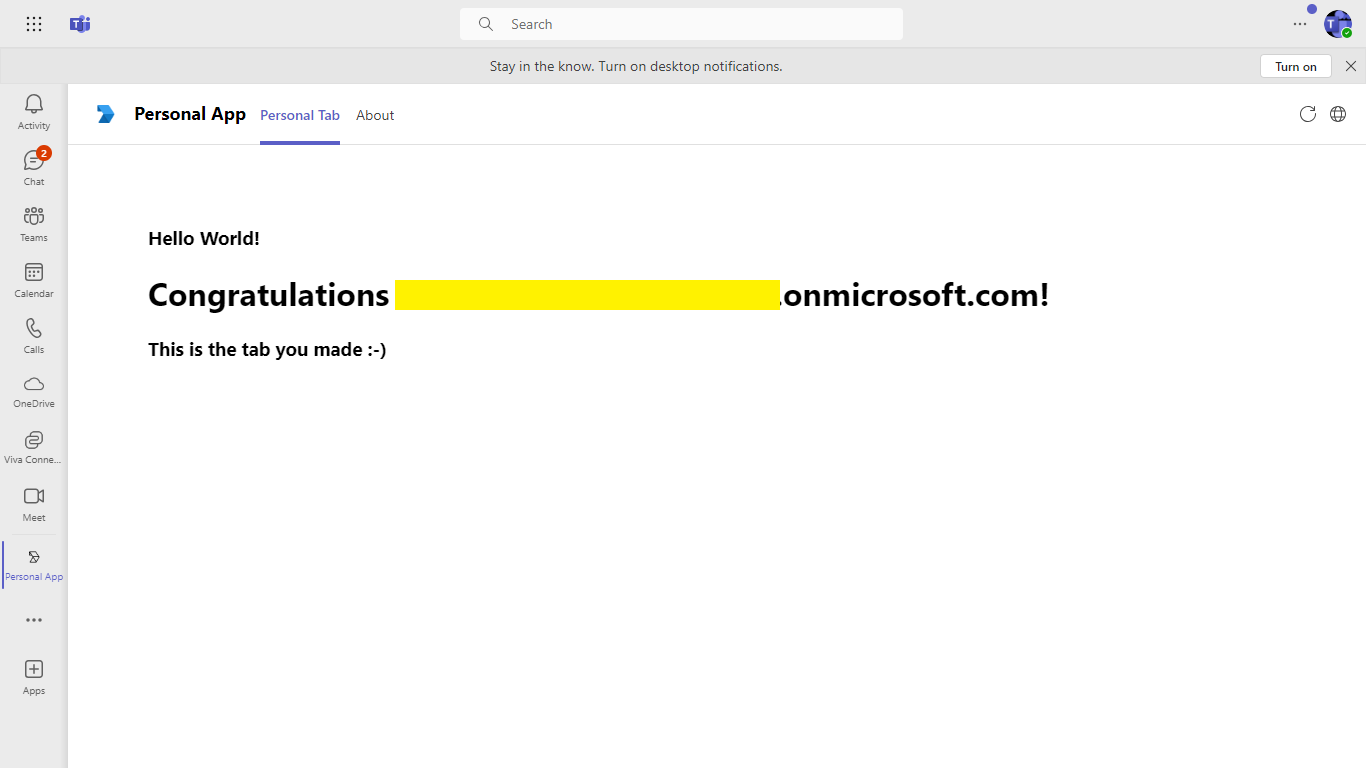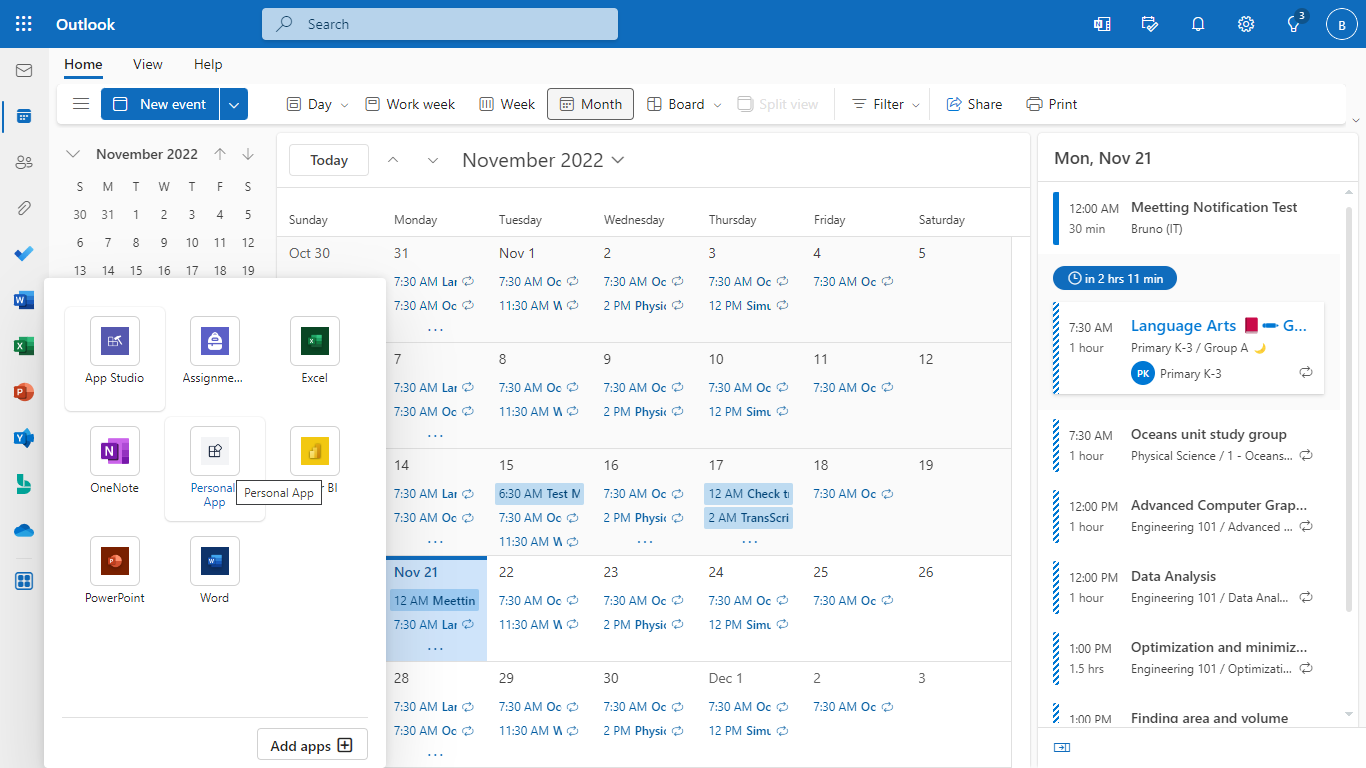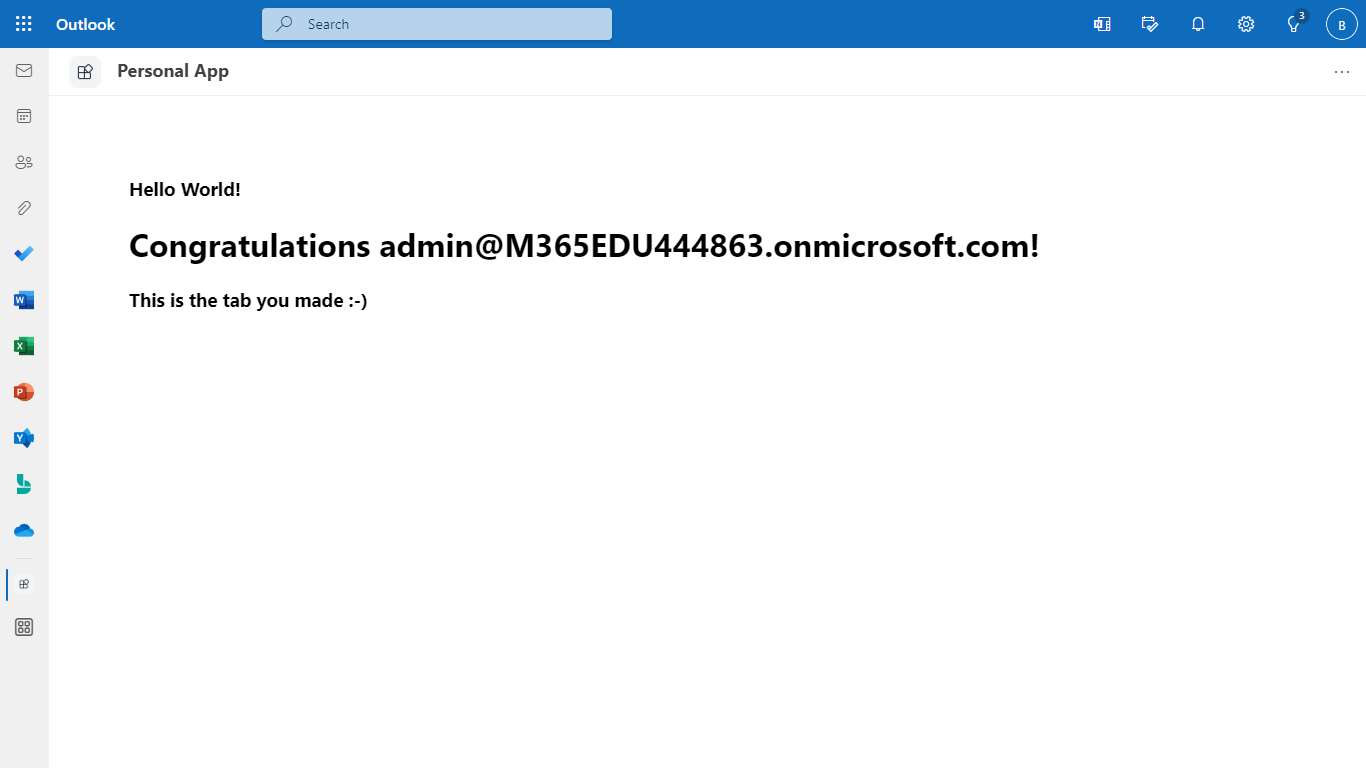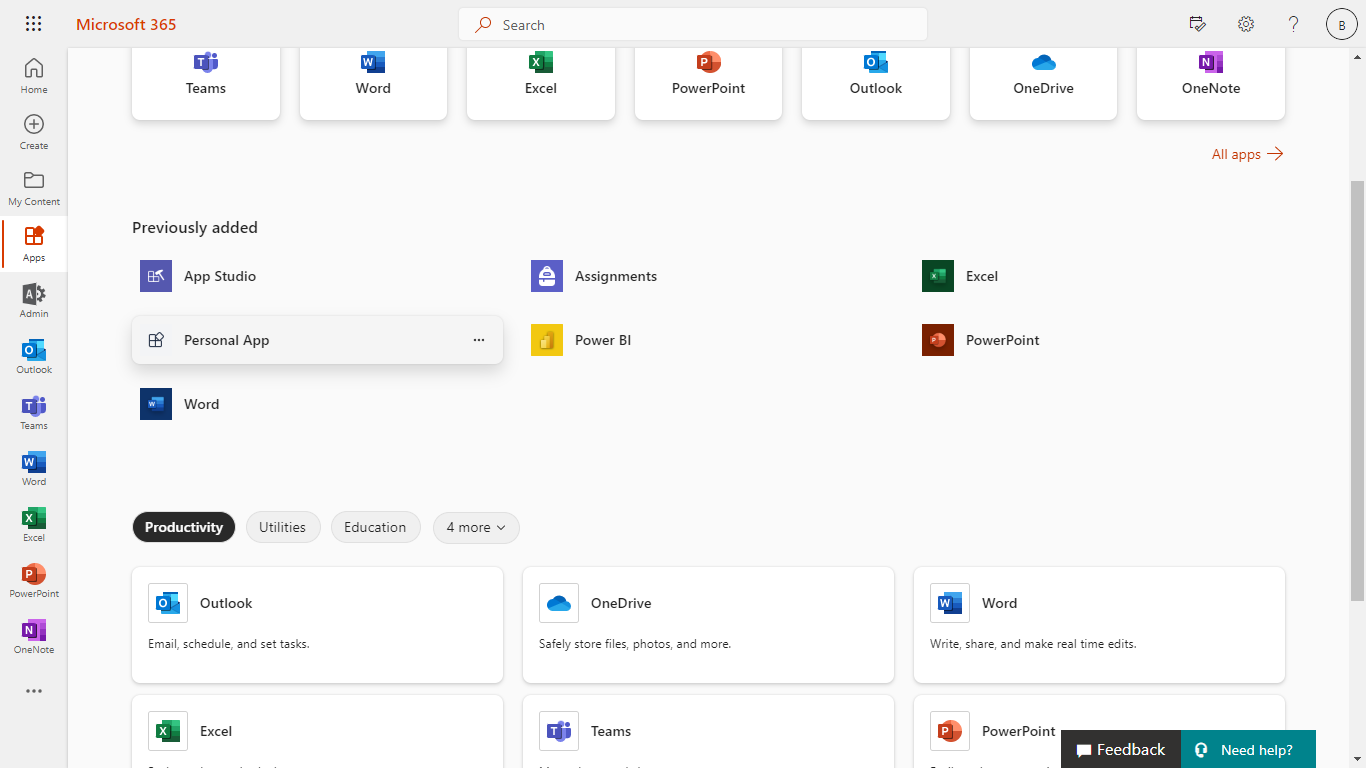| page_type | description | products | languages | extensions | urlFragment | |||||||||
|---|---|---|---|---|---|---|---|---|---|---|---|---|---|---|
sample |
This quick-start sample provides detailed instructions for developing a personal tab in Microsoft Teams with TypeScript, featuring essential setup and deployment guidance. |
|
|
|
officedev-microsoft-teams-samples-tab-personal-quickstart-ts |
This sample application serves as a comprehensive guide for creating a personal tab in Microsoft Teams using TypeScript. It includes step-by-step instructions on setting up your development environment, configuring the app manifest, and deploying your tab across Teams, Outlook, and Office, empowering developers to easily implement and test their custom solutions.
- Tabs
-
M365 developer account or access to a Teams account with the appropriate permissions to install an app.
-
dev tunnel or Ngrok (For local environment testing) latest version (any other tunneling software can also be used)
-
Teams Microsoft Teams is installed and you have an account
The simplest way to run this sample in Teams is to use Teams Toolkit for Visual Studio Code.
- Ensure you have downloaded and installed Visual Studio Code
- Install the Teams Toolkit extension
- Select File > Open Folder in VS Code and choose this samples directory from the repo
- Using the extension, sign in with your Microsoft 365 account where you have permissions to upload custom apps
- Select Debug > Start Debugging or F5 to run the app in a Teams web client.
- In the browser that launches, select the Add button to install the app to Teams.
If you do not have permission to upload custom apps (sideloading), Teams Toolkit will recommend creating and using a Microsoft 365 Developer Program account - a free program to get your own dev environment sandbox that includes Teams.
- Register a new application in the Microsoft Entra ID – App Registrations portal.
- Select New Registration and on the register an application page, set following values:
- Set name to your app name.
- Choose the supported account types (any account type will work)
- Leave Redirect URI empty.
- Choose Register.
- On the overview page, copy and save the Application (client) ID, Directory (tenant) ID. You’ll need those later when updating your Teams application manifest and in the appsettings.json.
-
Under Manage, select Expose an API.
-
Select the Set link to generate the Application ID URI in the form of
api://{AppID}. Insert your fully qualified domain name (with a forward slash "https://accionvegana.org/accio/0ITbvNmLiVHa0l2Z6MHc0/" appended to the end) between the double forward slashes and the GUID. The entire ID should have the form of:api://fully-qualified-domain-name/{AppID}- ex:
api://%ngrokDomain%.ngrok-free.app/00000000-0000-0000-0000-000000000000.
- ex:
-
Select the Add a scope button. In the panel that opens, enter
access_as_useras the Scope name. -
Set Who can consent? to
Admins and users -
Fill in the fields for configuring the admin and user consent prompts with values that are appropriate for the
access_as_userscope:- Admin consent title: Teams can access the user’s profile.
- Admin consent description: Allows Teams to call the app’s web APIs as the current user.
- User consent title: Teams can access the user profile and make requests on the user's behalf.
- User consent description: Enable Teams to call this app’s APIs with the same rights as the user.
-
Ensure that State is set to Enabled
-
Select Add scope
- The domain part of the Scope name displayed just below the text field should automatically match the Application ID URI set in the previous step, with
/access_as_userappended to the end:- `api://[ngrokDomain].ngrok-free.app/00000000-0000-0000-0000-000000000000/access_as_user.
- The domain part of the Scope name displayed just below the text field should automatically match the Application ID URI set in the previous step, with
-
In the Authorized client applications section, identify the applications that you want to authorize for your app’s web application. Each of the following IDs needs to be entered:
1fec8e78-bce4-4aaf-ab1b-5451cc387264(Teams mobile/desktop application)5e3ce6c0-2b1f-4285-8d4b-75ee78787346(Teams web application) Note If you want to test or extend your Teams apps across Office and Outlook, kindly add below client application identifiers while doing Azure AD app registration in your tenant:4765445b-32c6-49b0-83e6-1d93765276ca(Office web)0ec893e0-5785-4de6-99da-4ed124e5296c(Office desktop)bc59ab01-8403-45c6-8796-ac3ef710b3e3(Outlook web)d3590ed6-52b3-4102-aeff-aad2292ab01c(Outlook desktop)
-
Navigate to API Permissions, and make sure to add the follow permissions:
-
Select Add a permission
-
Select Microsoft Graph -> Delegated permissions.
- User.Read (enabled by default)
-
Click on Add permissions. Please make sure to grant the admin consent for the required permissions.
-
Navigate to Authentication If an app hasn't been granted IT admin consent, users will have to provide consent the first time they use an app. Set a redirect URI:
- Select Add a platform.
- Select web.
- Enter the redirect URI for the app in the following format:
https://%ngrokDomain%.ngrok-free.app/Auth/End. This will be the page where a successful implicit grant flow will redirect the user.
Enable implicit grant by checking the following boxes:
✔ ID Token
✔ Access Token -
Navigate to the Certificates & secrets. In the Client secrets section, click on "+ New client secret". Add a description (Name of the secret) for the secret and select “Never” for Expires. Click "Add". Once the client secret is created, copy its value, it need to be placed in the appsettings.json.
- Setup NGROK
-
Run ngrok - point to port 3978
ngrok http 3978 --host-header="localhost:3978"Alternatively, you can also use the
dev tunnels. Please follow Create and host a dev tunnel and host the tunnel with anonymous user access command as shown below:devtunnel host -p 3978 --allow-anonymous
- Setup for code
-
Clone the repository
git clone https://github.com/OfficeDev/Microsoft-Teams-Samples.git
-
In a terminal, navigate to
samples/tab-personal-quickstart/ts -
Install modules
npm install
-
Run your app
npm start
- Setup Manifest for Teams
- This step is specific to Teams.
Edit the
manifest.jsoncontained in theappManifest/folder to replace with your MicrosoftAppId (that was created in step1.1 and is the same value of MicrosoftAppId in.envfile) everywhere you see the place holder string{{Microsoft-App-Id}}(depending on the scenario the Microsoft App Id may occur multiple times in themanifest.json) Edit themanifest.jsonforvalidDomainsand replace{{domain-name}}with base Url of your domain. E.g. if you are using ngrok it would behttps://1234.ngrok-free.appthen your domain-name will be1234.ngrok-free.appand if you are using dev tunnels then your domain will be like:12345.devtunnels.ms. Note: If you want to test your app across multi hub like: Outlook/Office.com, please update themanifest.jsonin thetab-personal-quickstart\ts\appManifest_Hubfolder with the required values. Zip up the contents of theappManifest/folder to create amanifest.ziporappManifest_Hub/folder to create aappManifest_Hub.zipUpload themanifest.zipto Teams (in the left-bottom Apps view, click "Upload a custom app")
Start debugging the project by hitting the F5 key or click the debug icon in Visual Studio Code and click the Start Debugging green arrow button.
On the first time running and debugging your app you need allow the localhost certificate. After starting debugging when Chrome is launched and you have installed your app it will fail to load.
- Open a new tab
in the same browser window that was opened - Navigate to
https://localhost:3000/tab - Click the
Advancedbutton - Select the
Continue to localhost
Ensure you have the Debugger for Chrome/Edge extension installed for Visual Studio Code from the marketplace.
npm run build
Install App:
Personal Tab UI:
-
To view your app in Outlook on the web.
-
Go to Outlook on the weband sign in using your dev tenant account.
On the side bar, select More Apps. Your sideloaded app title appears among your installed apps
Select your app icon to launch and preview your app running in Outlook on the web
Note: Similarly, you can test your application in the Outlook desktop app as well.
-
To preview your app running in Office on the web.
-
Log into office.com with test tenant credentials
Select the Apps icon on the side bar. Your sideloaded app title appears among your installed apps
Select your app icon to launch your app in Office on the web
Note: Similarly, you can test your application in the Office 365 desktop app as well.
Builds the app for production to the build folder.
It correctly bundles React in production mode and optimizes the build for the best performance.
The build is minified and the filenames include the hashes.
Your app is ready to be deployed!
See the section about deployment for more information.
tab-personal-quickstart Extend Teams apps across Microsoft 365






